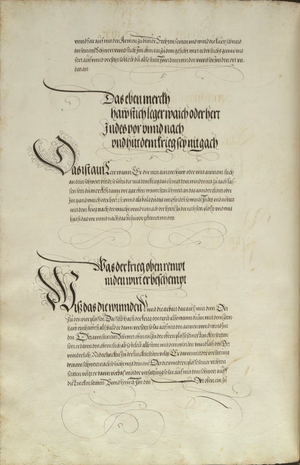|
|
You are not currently logged in. Are you accessing the unsecure (http) portal? Click here to switch to the secure portal. |
Difference between revisions of "User:Kendra Brown/Latin Lew/Piece 020"
Kendra Brown (talk | contribs) |
Kendra Brown (talk | contribs) (→Munich) |
||
| Line 80: | Line 80: | ||
====Sandbox Latin==== | ====Sandbox Latin==== | ||
| − | # | + | # Item cum adversarius ex forma punctionis vel Ictus ensem tuum contigerit, |
| − | # | + | # in primo conflictu, |
| − | # | + | # tu noli exercere statim Ictus crebros, |
| − | # | + | # sed festina lentè, |
| − | + | # ''et maximè curabis,'' | |
| − | # | + | # ''ut prius observes num in ensium collisione molliter vel fortiter ensem teneat,'' |
| − | # | + | # Sin id deprehenderis, |
| − | + | # uti poteris intorsionibus,[^1] | |
| − | + | # atque crebris ictibus quem habitum nos Germani bellum appellamus appetendo nuditates proximè obvias. | |
| − | |||
| − | |||
| − | |||
| − | |||
| − | # | ||
| − | # | ||
| − | # | ||
| − | |||
| − | |||
| Line 104: | Line 95: | ||
====Sandbox English from Latin==== | ====Sandbox English from Latin==== | ||
| − | # | + | # Also, when the adversary touches your sword from the form of thrust or strike, |
| − | + | # in the first conflict, | |
| − | # | + | # do not immediately practice repeated strikes, |
| − | + | # but hasten slowly, | |
| − | + | # ''and you will take the greatest care,'' | |
| − | # | + | # ''in order to observe earlier whether he holds the sword gently or strongly in the striking together of swords,'' |
| − | # | + | # but if you catch this, |
| − | # | + | # you are able to use the wrapping, |
| − | # | + | # and within the timeframe of the repeated strikes (which is the aspect of the art that we Germans call beautiful/warfare) you attack by closely seeking the opening. |
| − | + | ||
| − | # but | ||
| − | |||
| − | # | ||
| − | # and | ||
| − | |||
| − | |||
| − | |||
| − | |||
====Smooth English from Latin==== | ====Smooth English from Latin==== | ||
| + | |||
| + | When the adversary makes contact with your sword during an initial attack, ''don't immediately try to hit back, but take care to determine quickly whether he holds the sword strongly or gently.'' If you can catch it, you can use wrappings, and you attack by closely seeking the opening during the repeated strikes (which we Germans call beautiful/warfare). | ||
==Notes== | ==Notes== | ||
Revision as of 18:10, 23 September 2025
Contents
Dresden
German
Transcription
[3] Was der krieg oben rempt
niden wirt er beschempt
Wisz das die winnden Vnnd die arbait darausz mit dem Ort zu den vier plössen Dasselb haist der krieg. den treib also wann du Im mit dem zornhaw einhawest. Alsz bald er dann versetzt so far auf mit den armen vnnd wind Im den Ort ann seinem Schwert oben ein zu der obern plosse seiner Lincken seite. setzt er dann den obern stich ab. so beleib also steen mit dem winden. vnnd lasz den Ort vnndersich Nidersincken zu der lincken seiten volgt Er dann mit der versatzung deinem schwert nach so suche mit deinem Ort die vnndern plösse seiner rechten seite. volgt er dann virbas mit der versatzung so far auf mit dem schwert auff die Lincken seite. Vnnd henng Im den ~~~~ Ort oben ein zu
[1] der obern plössen. seinner rechten seiten. Vnnd also wirt er mit dem krieg vnnden vnnd oben beschempt. Ist das du In recht treybest.
Sandbox German
- Was der krieg oben rempt
- niden wirt er beschempt
- Wiß das die winnden Vnnd die arbait darauß mit dem Ort zu den vier plossen Dasselb haist der krieg,
- den treib also wann du Im mit dem Zornhaw ein hawest,
- alß bald er dann versetzt so far auf mit den armen vnnd wind Im den Ort ann seinem Schwert oben ein zu der obern plosse seiner Lincken seitten,
- setzt er dann den obern stich ab,
- so beleib also steen mit dem winden,
- vnnd laß den Ort vnndersich Nidersincken zu der lincken seiten volgt Er dann mit der versatzung deinem schwert nach so suche mit deinem Ort die vnndern plösse seiner rechten seitten,
- volgt er dann virbas mit der versatzung so far auf mit dem schwert auff die Lincken seitten,
- Vnnd henng Im den Ort oben ein zu
- der obern plössen,
- seiner rechten seiten,
- Vnnd also wirt er mit dem krieg vnnden vnnd oben beschempt,
- Ist ^das^ du in recht treÿbest
English
Sandbox English from German
- Whatever the war [verbs][1] above,
- it [the war] is shamed by it [the whatever] below.
- Know that the twists, and the work from there with the point at the four openings, is called the war.
- Execute it like this: When you strike at him with a Wrath cut,
- as soon as he counteracts, move up with your arms, and twist the point on their sword above at the upper opening on their left side.
- If he counteracts the upper thrust,
- then continue in the twists,
- and let the point drop downward to their left side. If he follows with the counteraction of your sword, then, with your point, seek the lower openings on their right side.
- If he continues with the counteraction, then move up with your sword on the left side,
- and hang the point in above at [88r] the upper opening
- of their right side.
- And in this way, he will be shamed by the war below and above,
- if you do it correctly.
Smooth English from German
- Whatever the war [verbs] above,
- it [the war] is shamed by it [the whatever] below.
Know that the twists, and the work with the point at the four openings from the twists, is called the war. Execute it like this: When you strike at him with a Wrath cut, as soon as he counteracts, raise your arms, and twist the point on their sword above at the upper opening on their left side. If he counteracts this upper thrust, then continue in the twists, and let the point drop downward to their left side. If he follows your sword with the counteraction, then seek the lower openings on their right side with the point. If he continues to counteract, then raise your sword on the left side, and hang the point in from above at [88r] the upper opening of their right side. And in this way, he will be shamed by the war below and above, if you do it correctly.
Munich
Latin
Transcription
[3] Item cum adversarius ex forma punctionis vel Ictus ensem tuum contigerit, in primo conflictu, tu noli exercere statim Ictus crebros, sed festina lentè, et maximè curabis, ut prius observes num in ensium collisione molliter vel fortiter ensem teneat, Sin id deprehenderis, uti poteris intorsionibus, atque crebris ictibus quem habitum nos Germani bellum appellamus appetendo nuditates proximè obvias.
Sandbox Latin
- Item cum adversarius ex forma punctionis vel Ictus ensem tuum contigerit,
- in primo conflictu,
- tu noli exercere statim Ictus crebros,
- sed festina lentè,
- et maximè curabis,
- ut prius observes num in ensium collisione molliter vel fortiter ensem teneat,
- Sin id deprehenderis,
- uti poteris intorsionibus,[^1]
- atque crebris ictibus quem habitum nos Germani bellum appellamus appetendo nuditates proximè obvias.
English
Sandbox English from Latin
- Also, when the adversary touches your sword from the form of thrust or strike,
- in the first conflict,
- do not immediately practice repeated strikes,
- but hasten slowly,
- and you will take the greatest care,
- in order to observe earlier whether he holds the sword gently or strongly in the striking together of swords,
- but if you catch this,
- you are able to use the wrapping,
- and within the timeframe of the repeated strikes (which is the aspect of the art that we Germans call beautiful/warfare) you attack by closely seeking the opening.
Smooth English from Latin
When the adversary makes contact with your sword during an initial attack, don't immediately try to hit back, but take care to determine quickly whether he holds the sword strongly or gently. If you can catch it, you can use wrappings, and you attack by closely seeking the opening during the repeated strikes (which we Germans call beautiful/warfare).
Notes
- ↑ Meanings of räumen:
- a) vacates/abandons b) yields, makes room for, frees up, c) removes d) needs to remove
- remove the cream: unlikely
- whisper, spread rumors
- rhyme

